How to Make Compost
Share
Yes, I succeeded to move past my apprehension and embark into this new world of composting at home. And I am LOVING IT!!!!!!!!! I cannot tell you how good it is making me feel and it is surprisingly quite simple.
I really had no idea what I was doing at all and for me when I don’t know what I don’t know then I can’t work out my next right action and usually I just give up or not bother trying. So if you are anything like me and are keen to begin but have no idea what to do, I have attempted to break it down into 4 clear and simple steps of how to compost at home. So let’s start at the beginning…
Step 1
3 Decisions to consider regarding a suitable home composting system:
1. Location
- How much space – do you have both internally and externally? Are you living in a unit or a house? Do you have a small or large outdoor area?
- Who will it effect – i.e. pets/young children/neighbours/landlord?
- Where will you place the composting system – do you want to have the internal bins close to your cooking space so that the food peels and scraps can be readily disposed of? Or hidden away? Do you have a garden space that attracts the sun? A flat space? Hidden away? Pathway, paved area, garden bed?
2. Output
-
How much waste do you produce within your home and garden?
- Grass clippings – do you have a large outdoor area that you maintain
- Food waste – Do you produce more than ½ a 7 litre kitchen caddy per day? (see below more information of what constitutes as food waste)
3. Investment
How much time and money do I want to invest? Do you want to build one yourself out of wood, buy an inexpensive slow cycle stationary one or invest in a low maintenance quick turnaround tumbling one? You may even choose to have a combination of these options.
The right home composting system for me & why:
My current set up is that we live in a relatively humble size house with a large garden. We have two young children and a dog and life is super busy. I wanted minimal commitment, minimal effort and minimal investment for my minimal waste.
I have found through this exercise that my household consistently produces roughly half a caddy a day in organic food waste. I was surprised at how much there was when I first started collecting as I didn’t believe I was throwing away that much food to landfill but I quickly saw that it added up. It consisted mainly of the peels and cores from the vegetables & fruit we consume, the crusts from the bread my children don’t eat, the tea leaves, the mouldy food, the leftover scraps from dinner, or lunchboxes and breakfast. Click here for a free printable on what basic household items can be added to your composting bins. Further our large garden produces several lawn mower catchers per week of grass and garden clippings.
My choice of composting system:
I chose to go with:
- A 7 litre Kitchen caddy for inside our house.
- A 160 litre twin continuous compost tumbler outside in our garden
- A 300 litre free standing stationary compost bin outside in our garden.
My Reasons:
- Kitchen Caddy: I collected my waste for a week and weighed it each day to work out that 7 litres was the right size for our household. The caddy I chose has a lockable lid so that it prevents any odours and avoids tipping waste over. I also purchased some 7 litre compostable bags to line my caddy, to keep it clean and to make it easy for me to transfer outside. I have placed it on my kitchen bench next to my chopping board so that I have easy access as well as a constant reminder when cooking/cleaning to dispose of the organic waste effortlessly.
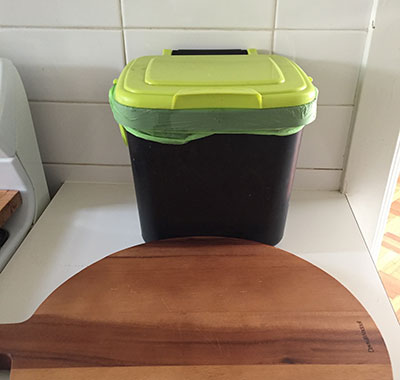
- Roto Compost tumbler: I chose this one for several reasons:
- It is quick: As tumblers allow for maximum aeration of the waste they can make compost twice as fast as a standing bin.
- It is continuous: It has a two chamber design so I am able to fill up one side of the bin while the other side is maturing. This results in a continuous supply of compost.
- It requires little maintenance because the rolling action of the tumbler ensures it is easily aerated. As long as I spin it each time I fill it up (every second day) then that is all that is required.
- The lid slides across securely so that if it tips over the rubbish will not fall out
- It is off the ground which is a great deterrent from pests and other animals and it makes it easy to stick a bucket underneath it and let the compost drop out
- The tumbler is easy to spin and minimal manual labour is required…no elbow grease or back breaking wanted here!! It is easier to spin because firstly it is a compact unit and secondly because it is a horizontal turning compost bin not a vertical one which means that the weight of the waste inside does not need to travel as high. I didn’t choose a bigger tumbler for this reason as it would be harder to turn and harder to empty.
I placed the compost tumbler at the back of our garden as it has great access to sunlight which can warm up the compost bin and can assist to move along the harvesting process (this is why in summer composting is quicker than in winter). Further, it is the furthest point in our garden from the house so that if it starts smelling or attracts fruit flies it is far away. Let’s face it as a novice I am unlikely to get the recipe spot on to begin with and until I master it this is the reality of what is likely to happen!!
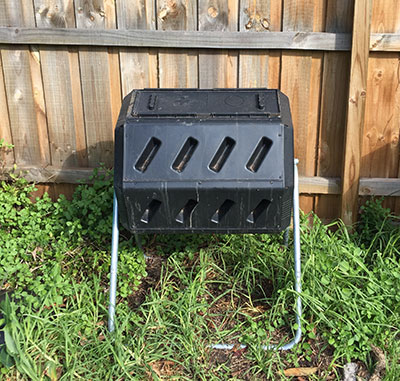
- I decided I needed two compost bins outside our house due to the excessive grass clippings we produce from our large garden. Please note however, that if our garden was smaller it would be fine to use just the one unit. I chose the tumbler for the food waste and a stationary unit for the garden waste. This is due to the fact that food waste, as opposed to garden waste produces the most nutrient rich compost. I really wanted access to the rich compost quickly and steadily whereas I the garden waste can work in a much more suitable slower system.
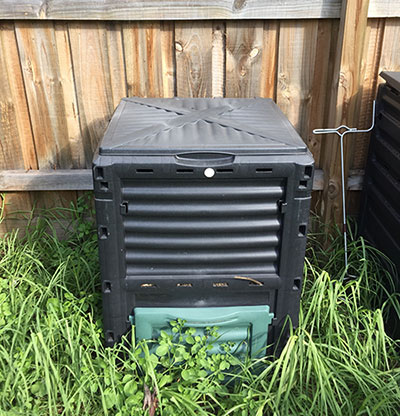
Are there any other decisions you have to make before moving forward? Who will be the one responsible for looking after it? If you need a reminder click here for the 4 reasons we should all be composting at home!!! Would love to hear about your specific set-up and let me know if you have any queries.
Decisions have been made, now the good bit – let’s go shopping
Step 2:
Tools required for composting at home:
- Kitchen caddy (click here to see some options)
- Compost tumbler (click here to see some options)
- Stationary Compost bin (click here to see some options)
- A sift/strainer
- A shovel
- Gardening gloves (for the princesses out there like me)
- Compostable bags (click here to see some options)
- Activator (click here to see some options)
- A list of what items to place in your compost bin. Here is a list of what you can compost.
*Please note that all these items can be purchased at Bunnings.
Are you feeling ready? Do you have any other questions at this stage?
Ready to begin. All items on hand and in position…get ready to save the world!! So what do I do?
Step 3:
Build some new habits:
- Sorting household waste into the correct bins is what it is all about. Learning what goes into which bin is the challenge. At my house we have three bins: General waste, Recycling & the compost bin. I keep our compost caddy right next to the chopping board for convenience.
- Here is a chart of the everyday household items that can be thrown straight into the compost caddy:
| Greens (Nitrogen) | Browns (Carbon) |
|---|---|
| Egg shells | Paper towel |
| Grass clippings | Paper and Cardboard (without waxy surfaces) |
| Fruit (not citrus), peels and cores* | Ash |
| Vegetables and peels* | Dry leaves |
| Coffee grounds | Woodchips |
| Tea bags and leaves (remove staples) | Straw |
| Bread and Pasta | Egg carton (without the labels) |
| *hard skin and pips take longer to decompose | Toilet paper and Newspaper |
- Get the family on board to throw items away in the correct bins.
- Chop up waste into small chunks, crumple up cartons, shred paper and crush egg shells. The smaller the pieces are the quicker they will decompose. And likewise the harder the items are such as an avocado pip and pumpkin skin then the longer it will take to breakdown.
- Empty the kitchen caddy every second day into the outside compost tumbler.
- Give the tumbler a spin each time waste is added.
- Add your organic waste with moist (green) and dry (brown) ingredients generally at a 30:70 (moist : dry) ratio
- Click here for a free printable of these basic recipe that you can compost to keep on hand. If you are looking for a more detailed list please click here of what is considered brown or green waste and whether it can go in your compost bin.
- The browns will absorb the excess moisture out of the greens, so add more brown as you go if it is too wet looking.
- Water as needed if too dry.
- Once one side of the chamber is full, you turn the lid over on the tumbler so that it is easily identifiable as either the adding side or the maturing side. You then start filling the other side and leave the original side to mature. This can take between 8-10 weeks (roughly the time it takes to fill the new side). And the process continues.
I love Gretchen Rubin, who writes, researches and talks about habits and how our lives can change if we change our habits. It is always challenging to instigate a new process/flow into our lives and one of the tips from her book called “better than before” that I think can really help you to incorporate composting into your life is the strategy of convenience and inconvenience. The premise here is that we are more likely to keep to a new behaviour if it is convenient. Conversely, we are more likely to stop an old bad habit if we make it inconvenient. For example you can keep the compost caddy right next to your chopping board, or at a height that the children can see and reach and you can place the regular waste bin further away and inside a cupboard. This makes it convenient to place the organic waste into the correct bin and inconvenient to throw it in the general waste bin as it will take more effort and time to do so.
Well I must say that it has been a fairly smooth transition here in my household and the kids are on board. On occasion I have needed to remind them but thankfully their school is into composting so they are not “new” to the concept.
Step 4 will explore the finished product so watch this space!
How do you form new habits in your home? Is everyone on board to want to compost at your place? What is the resistance, if any?
Step 4:
Is my compost ready…now what?
It has been the required number of days (roughly 6 weeks) since I left the initial side of the tumbler to do its job. Yay!!! I am so excited and I have been eager to feed my garden with all my cooking. My vegetable peels, banana skin and egg shells are no longer visible. Mother Nature is miraculous. I am floored by this phenomenon but grounded by the solid habits we have formed over the last few months.
I researched that an easy way to find out if your compost is ready is by performing the sniff test. I must admit I do have a good nose on me…have always been able to spot where exactly our puppy has been in our garden, if a recipe needs more seasoning and what perfume you have chosen to wear. So whilst a seemingly informal process I am confident I will know by the smell of the compost heap if it is ready.
Basically what is required from the sniff test is to pop some of your compost into a snap lock bag and seal it. Wait a week and then take a whiff. It should have a pleasant, earthy, soil-like smell. If it smells foul or rotten or a bit like ammonia the compost is not completely finished and will need to be returned to the tumbler to continue harvesting for another week or two.
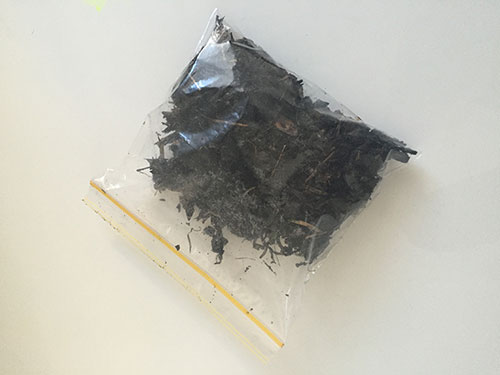
I put some of the compost into a bag and waited 7 days (Ok I cheated and took a whiff at 5 days…patience has never been my thing!!) And to my surprise it smelt great. And what I mean by great is that I half expected to be repelled by the smell but it actually barely had a scent at all. It was rather soil-like and even quite fresh. YAY!!! So excited!!!!!!!! That was a clear enough signal to me that it was ready.
So the day I have been waiting for. I geared up with some old jeans, boots and gardening gloves and found an old 30 litre flexi tub. I placed it directly underneath the tumbler (on the harvested side) and rolled the tumbler until the door faced the flexi tub. As I slid open the side of the door that was ready, some of it instantly fell out in a clump. The rest was probably a bit moist and needed some help. I rocked it a bit and then used a little trowel to shovel it out. This filled roughly two of these tubs.
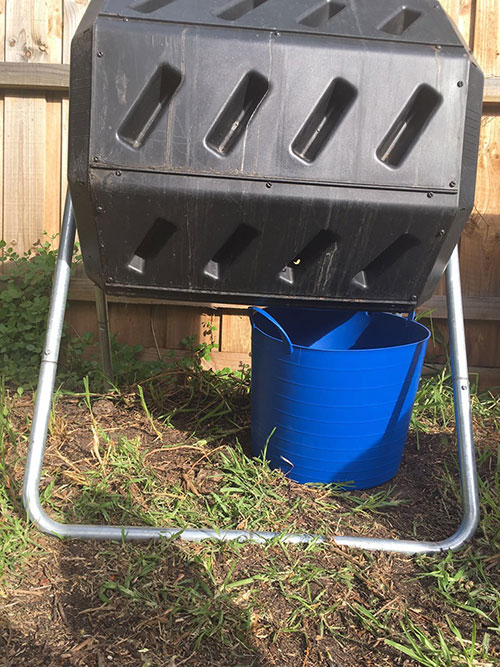
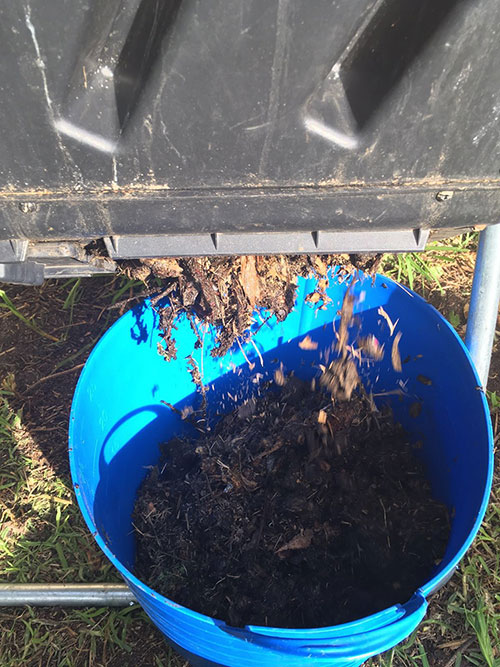
I took my bucket and dug this rich nutrient dense compost into our raised herb garden bed. Two buckets was more than enough and I had extra that I dispersed amongst the rest of our garden. I cannot believe how good it feels…on so many levels. Click here to read my research as to why we should all be composting at home.
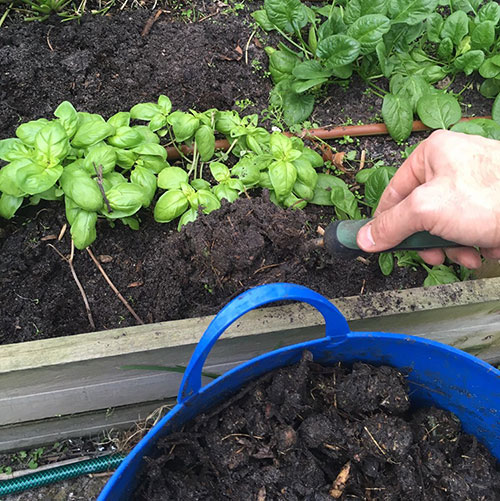
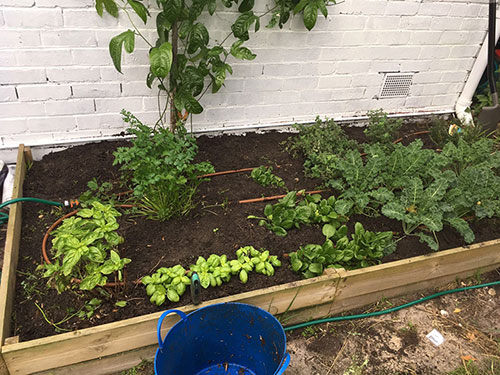
Would love to hear how you are traveling with your composting at home, any questions or thoughts about it please feel free to write to me.






